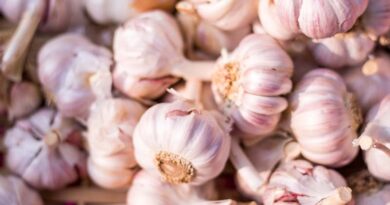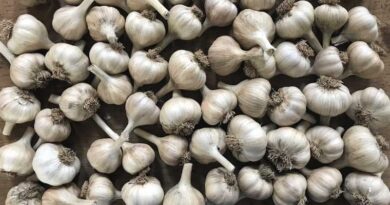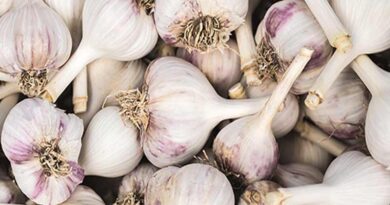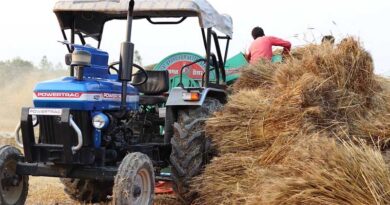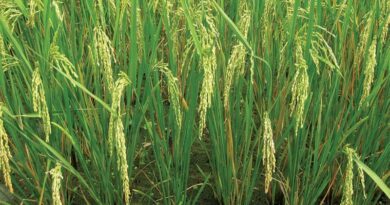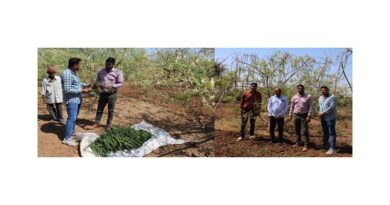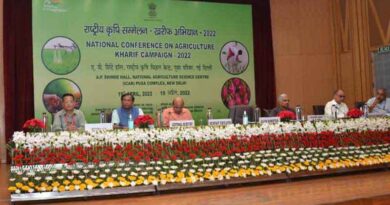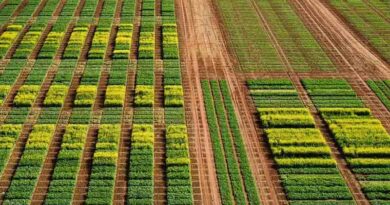High-Yielding Garlic Varieties for Farmers in Haryana, Punjab, Uttarakhand, Jammu, Himachal Pradesh, Uttar Pradesh, Rajasthan and Bihar
02 December 2023, New Delhi: Below are high-yielding varieties of garlic for North India. A suitable state in India for each variety is mentioned. It is important to follow the recommended fertilizer application to obtain the recommended yield. The recommended fertilizer dose is mentioned in the article ahead.
Yamuna Safed (G-1): Bulbs are compact, silvery white with creamy flesh. The diameter of the bulb is 4.0-4.5 cm. Cloves are sickle-shaped and 25-30 in number/bulb. They contain 38 0B total soluble solids,40% dry matter, and 29 micro mole/g pyruvic acid. The crop matures in 140-150 days. It gives an average yield of 150-175 q/ha. The variety is notified by the Government of India for cultivation all over the country.
Yamuna Safed-2 (G-50): Bulbs are compact and attractive with white creamy flesh. The diameter of the bulb is 3.5-4.0 cm. The number of cloves is 35-40 per bulb. They contain 39 0B total soluble solids, 41% dry matter, and 26 micro mole/g pyruvic acid. The crop matures in 140-160 days. It gives an average yield of 150-200 q/ha. The variety is notified by the Government of India for cultivation in the Northern parts of India.
Yamuna Safed-3 (G-282): Bulbs are creamy white, bigger in size, and 4.5-5.5 cm in diameter. The number of cloves is 15-16 per bulb. They contain 40 0B total soluble solids, 42% dry matter, and 25 micro mole/g pyruvic acid. The crop matures in 120-140 days. It gives an average yield of 175-200 q/ha. The variety has been notified by the Government of India for growing in Madhya Pradesh, Maharashtra, Haryana, Gujarat, Punjab, Rajasthan, Uttar Pradesh, and Chhattisgarh.
Yamuna Safed-4 (G-323): Bulbs are silvery-white and 3.5-4.0 cm in diameter. The number of cloves is 20-25 per bulb. They contain 42 0B total soluble solids, 44.5% dry matter, and 25 micro mole/g pyruvic acid. The crop matures in 140-150 days. The variety gives an average yield of 175-200 q/ha. It has been notified by the Government of India for growing in North and Central India.
Yamuna Safed-5 (G-189): Bulbs are creamy white and 4.5-5 cm in diameter. The number of cloves is 22-30 per bulb. The cloves contain 42 0B total soluble solids, 44% dry matter, and 26 micro mole/g pyruvic acid and are suitable for processing. The crop matures in 140-160 days. The variety gives an average yield of 150-180 q/ha. It has been notified by the Government of India for growing in Zone III (Delhi, Uttar Pradesh, Haryana, Bihar, and Punjab), Zone IV (Rajasthan and Gujarat), and Zone VI (Maharashtra, Karnataka, and Andhra Pradesh).
Yamuna Safed-8 (G-384): Bulbs are solid, white, flash-attractive, and dark green plants. The diameter of the bulb varies from 4.5 to 5.0 cm, with 22-30 cloves per bulb. Bulbs contain 41 0B total soluble solids, 42% dry matter, and 26 micro mole/g pyruvic acid. The crop matures in 150-160 days after sowing. The average yield of variety ranges from 175 to 200 q/ha. It has been notified by the Government of India for growing in Zone II (Jammu, Punjab, Delhi, Haryana, and Rajasthan).
Yamuna Safed-9 (G-386): Bulbs are solid, light purple skin, attractive creamy white flash, and dark green plants. The diameter of the bulb varies from 4.80 to 5.50 cm, cloves 22-30 per bulb. Bulbs contain 40 0B total soluble solids, 43% dry matter, and 25 micro mole/g pyruvic acid. The crop matures in 150-160 days after sowing. The average yield of variety ranges between 180 and 225 q/ha. The variety has been notified by the Government of India for growing in Zone II (Jammu, Punjab, Delhi, Haryana, and Rajasthan).
Agrifound Parvati (G-313): Bulbs are bigger, creamy white in color with a pinkish tinge. The diameter of the bulb varies from 5.0 to 6.5 cm, with 10-16 bigger cloves per bulb. Bulbs contain 36 0B total soluble solids, 38.5% dry matter, and 23 micro mole/g pyruvic acid. The crop matures in 230-250 days after sowing. The average yield of variety ranges between 200 to 225 q/ha.The variety has been notified by the Government of India for growing in Zone I (Jammu Kashmir, Himachal Pradesh, and Uttarakhand).
Agrifound Parvati-2 (G-408): Bulbs are bigger, creamy white in color. The diameter of a bulb varies from 5.0 to 6.0 cm, cloves are bigger with 12-14 in number per bulb. Bulbs contain 37 0B total soluble solids, 39% dry matter, and 23 micro mole/g pyruvic acid. The crop matures in 240-260 days after sowing. The average yield of variety ranges between 200 to 225 q/ha. It has been notified by the Government of India for growing in Zone I (Jammu Kashmir, Himachal Pradesh, and Uttarakhand).
Yamuna Purple-10 (G-404): Bulbs are compact, attractive light purple in colour with creamy flesh. The diameter of the bulb varies from 4.8 to 5.5 cm and bigger elongated cloves are 25-30 in number per bulb. Bulbs contain 40 0B total soluble solids, 42.9% dry matter, and 26.8 micro mole/g pyruvic acid. The crop matures in 230-250 days after sowing. The average yield of variety ranges between 200 and 225 q/ha. It has been notified by the Government of India for growing in Zone II (Delhi, Rajasthan, Haryana, Jammu & Kashmir, and Punjab) and Zone IV (Punjab, Tarai region of Uttar Pradesh, Uttarakhand, Bihar and Jharkhand)..
Yamuna Safed-7 (G-378): Plants are straight with dark green leaves. Bulbs are compact, and bold white in color. The diameter of the bulb varies from 4.50 to 4.80 cm and the number of cloves are 20-25 per bulb. Bulbs contain 38-39 0B total soluble solids, 41% dry matter, and 25.0 micro mole/g pyruvic acid. The crop matures in 145-150 days after sowing. The average yield ranges between 155 and 165q/ha. The variety has been recommended for growing in hilly areas.
Recommended sowing technique, spacing, and timing for high-yielding garlic crop
The planting of garlic cloves of 8-10 mm size at a spacing of 10-12.5 cm x 7.5. cm in October is recommended for obtaining higher bulb yield, however, for quality bulb production planting at 15.0 cm x 10.0 cm spacing is recommended. The planting of garlic is generally recommended from 15th October to 15th November however, planting from 15th October to 30th October is recommended for Karnal conditions of Haryana and 25th October to 5th November under Nashik conditions of Maharashtra.
Recommended fertilizer dose for high-yielding garlic crop
Besides Nitrogen-Phosphorus-Potash (NPK) (100:50:50 Kg/ha) the use of Sulphur @ 30-50 Kg/ha and Zinc sulphate @ 20 Kg./ha are recommended for enhancement in yield and quality. The use of specialty fertilizers (water soluble fertilizers) as NPK -19:19:19 @ 1 % at 30, 45, and 60 days after planting is recommended. This should be followed by NPK -13:0:45 @ 1 % at 75, 90, and 105 days after planting increases the yield and enhances the storability substantially. The fertigation in 10 splits is recommended for higher bulb yield.
For garlic integrated nutrient management is recommended. It can be a combination of 50% chemical fertilizer and 50% organic fertilizer or 70% chemical fertilizer and 30% organic fertilizer. For 50% chemical fertilizer, use (NPK @ 50:25:25 Kg/ha + Sulphur @ 25 Kg./ha + Zinc @ 10 Kg/ha + Azospirillum or Azotabactor @ 10 Kg./ha + Phosphate solubilizing bacteria @ 10 Kg/ha). For 70% chemical fertilizers, use (NPK @ 30:15:15 Kg/ha + Suphur @ 15 Kg./ha + Zinc @ 6 Kg/ha + foliar spray of Polyfeed @ 1 % at 15, 30, and 45 days after planting followed by Multi-K @ 1 % at 60, 75 and 90 days after planting). These doses of 50% and 70% chemical fertilizer will not reduce yield but will improve soil health in comparison to the standard 100% chemical dose (NPK @ 100:50:50 Kg/ha + S @ 50 Kg/ha +Zn @ 20 Kg/ha).
The farm application of GA3 @ 25 ppm at 45 & 60 days after planting has been recommended to enhance the yield of garlic and improve the quality under the Nashik conditions of Maharashtra and Karnal conditions of Haryana.
Use of Pendimethalin @ 3.5 l/ha + one hand weeding or Oxyfluorfen @ 0.25 Kg a.i/ha + one hand weeding is recommended for effective control of weeds in garlic.
Irrigation at 1.5 CPE (Cumulative Pan Evaporation) is recommended for a higher yield of quality garlic bulbs. Drip irrigation is recommended in garlic grown on a raised bed to get a higher bulb yield.
Foliar Diseases Management for Garlic Crop
Foliar spray of mancozeb (Dithane M-45) @ 0.25% or Ziram (Dithane Z-78) @ 0.3 % with sticker Triton @ 0.06% at fortnightly intervals after the appearance of disease is recommended to control the purple blotch (Alternaria porri) and stemphylium blight (Stemphylium vesicarium) of garlic.
15th October planting of garlic cloves in Nashik (Maharashtra) was found suitable for reducing the prevalence of diseases and thrips in garlic varieties like Yamuna safed, Yamuna safed-2, and Yamuna safed-3 and 15th September for Agrifound white during rabi season.
15th September planting of garlic clove in Karnal (Haryana) was found suitable for reducing the diseases and insect pests in garlic varieties like Yamuna safed, Yamuna safed-2, Yamuna safed-3 and 15th October for Agrifound white during rabi season
Management of thrips in Garlic Crop
Sprays of deltamethrin 2.8% EC @ 0.095% at 15-day intervals or fipronil 5% SC @ 0.1% at 10 days intervals or profenofos 50% EC @ 0.1% or spinosad 45% SC @ 0.1% is recommended for reducing thrips population and increasing yield.
Post Harvesting Technology for Garlic Crop
Harvesting of garlic at 75 – 100% neck fall stage, windrow curing till complete drying of tops and neck cutting leaving 2.5cm neck above the bulb, and storage in nylon-netted bags are recommended to reduce post-harvest losses in garlic. The cloves treated with Potassium orthophosphate solution @1% for 15 minutes before planting are recommended to minimize the storage loss in garlic. The garlic variety Yamuna sated-3 planting on 5th November is recommended for level losses at Nashik (for 6 months) as well as Karnal (for 9 months).
Artificial curing of garlic bulb variety Agrifound Parvati grown in Kullu Valley in a curing chamber with full load at 350C and velocity of airflow at 3.2 m/s. for 14 hours is also recommended for adoption in view of lower storage losses during storage.
The garlic genotype G-189 is recommended for processing purposes in view of having desired dehydration qualities.
Also Read: UPL Limited announces incorporation of Advanta Seeds Ltd in South Africa
(For Latest Agriculture News & Updates, follow Krishak Jagat on Google News)


